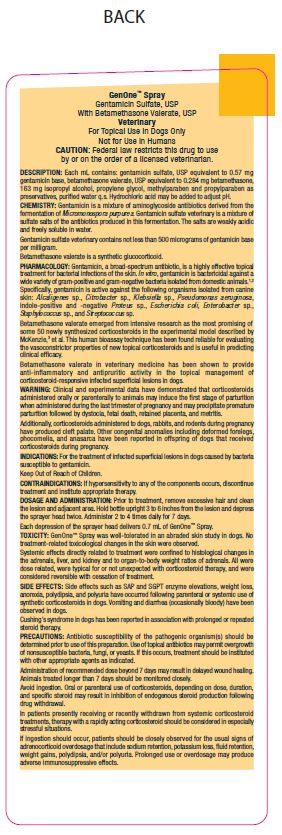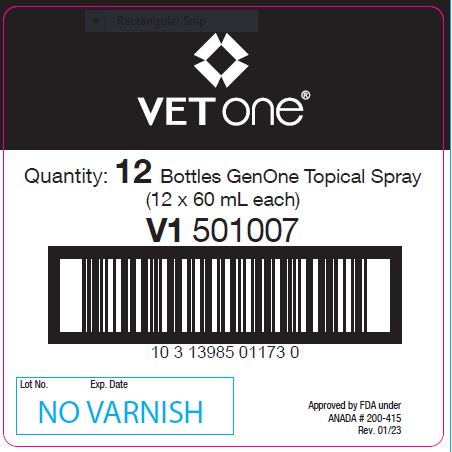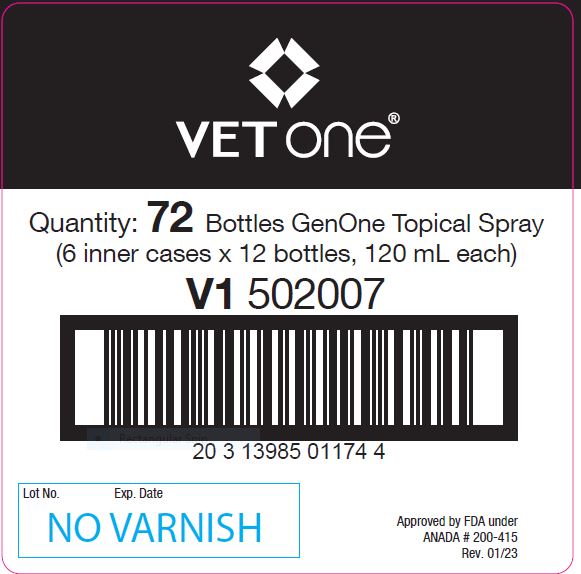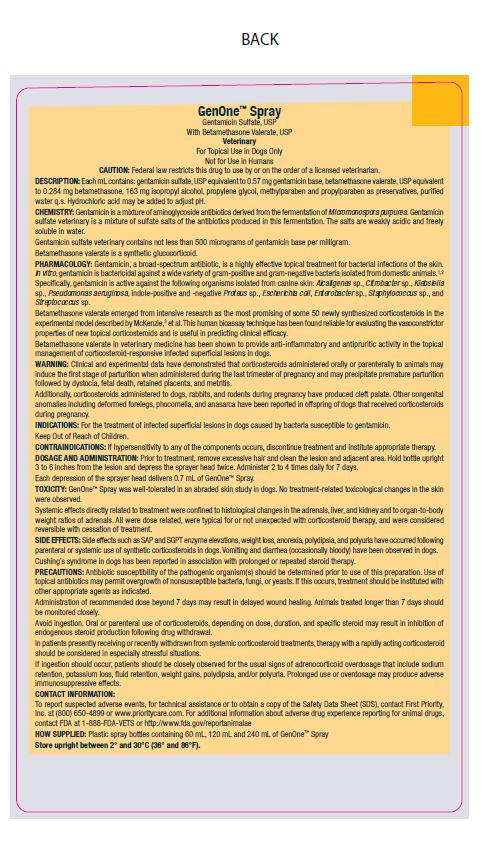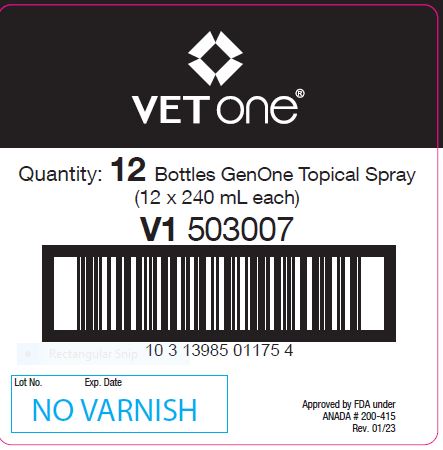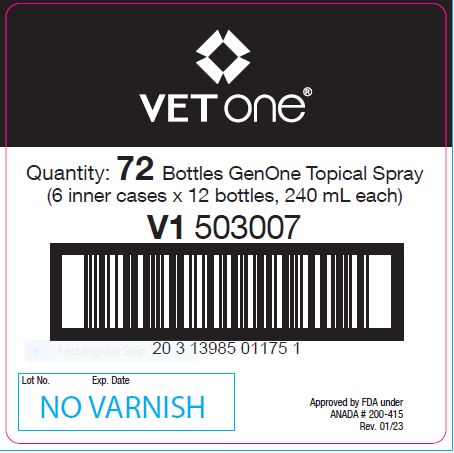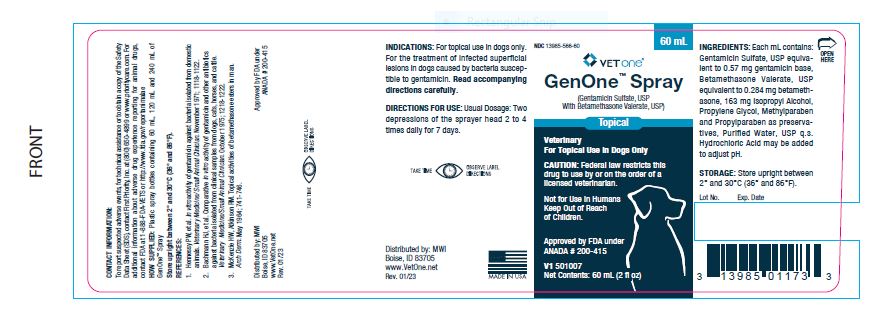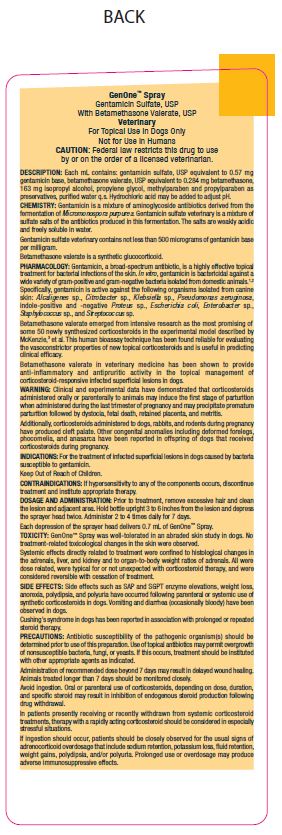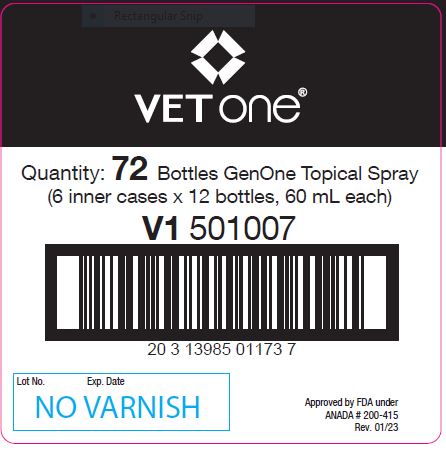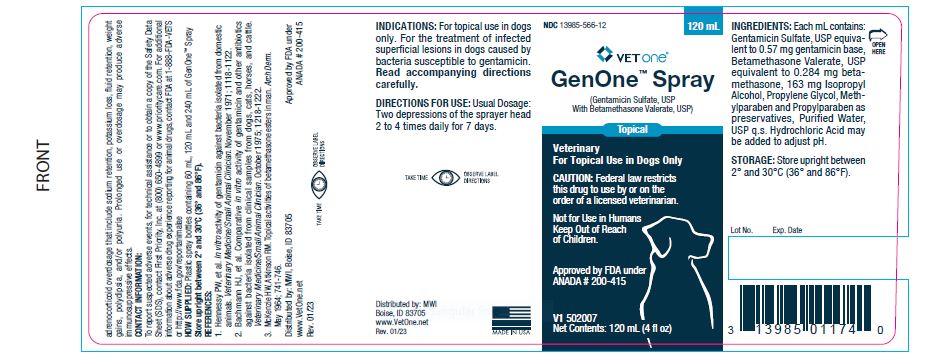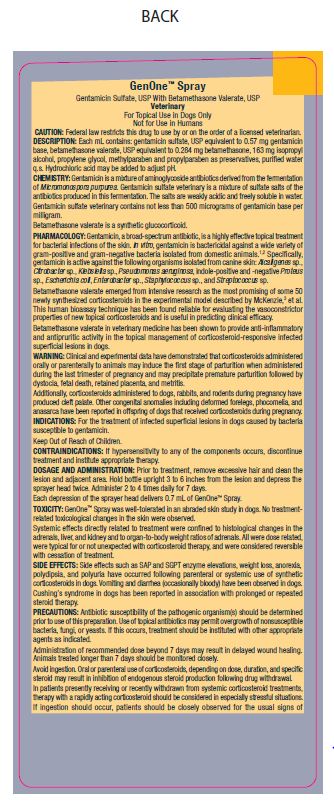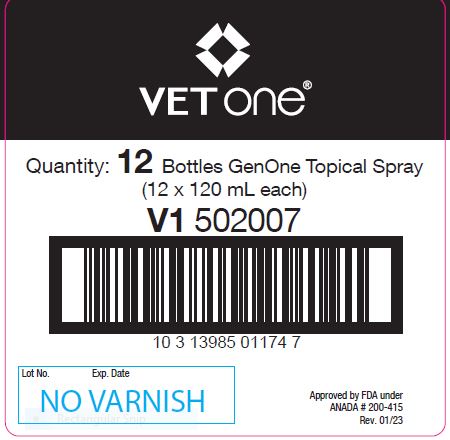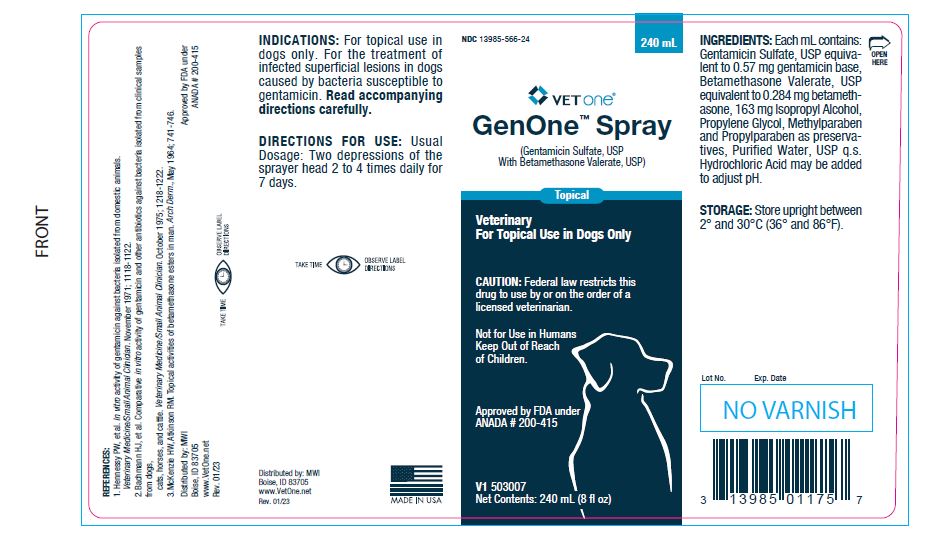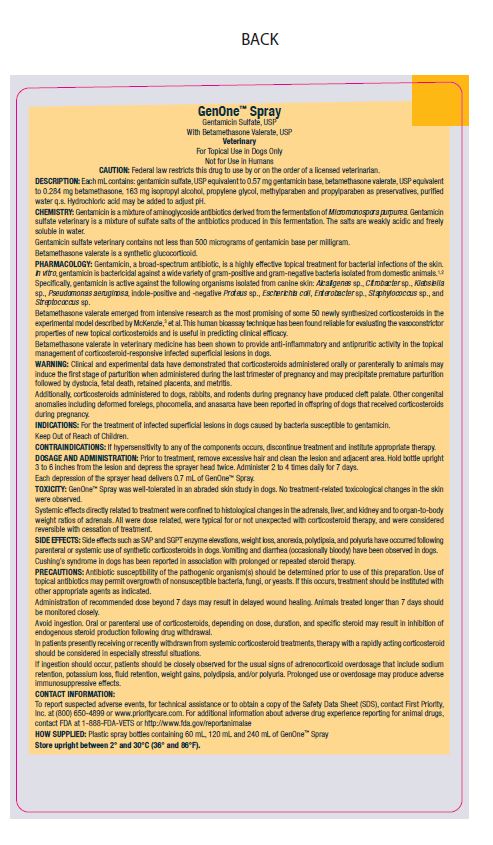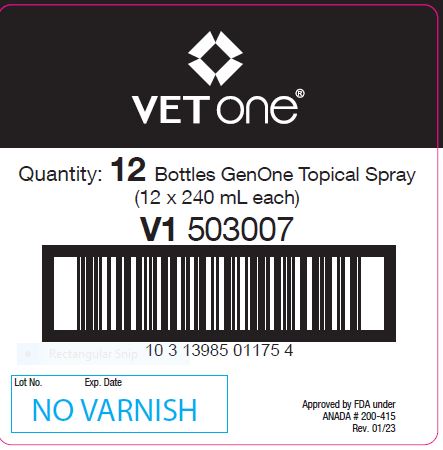Label: GENONE- gentamicin sulfate spray
- NDC Code(s): 13985-566-12, 13985-566-24, 13985-566-60
- Packager: MWI
- Category: PRESCRIPTION ANIMAL DRUG LABEL
- DEA Schedule: None
- Marketing Status: Abbreviated New Animal Drug Application
Drug Label Information
Updated September 26, 2023
If you are a consumer or patient please visit this version.
- Download DRUG LABEL INFO: PDF XML
- Official Label (Printer Friendly)
- INFORMATION FOR OWNERS/CAREGIVERS
- CAUTION:
-
DESCRIPTION:
Each mL contains: gentamicin sulfate, USP equivalent to 0.57 mg gentamicin base, betamethasone valerate, USP equivalent to 0.284 mg betamethasone, 163 mg isopropyl alcohol, propylene glycol, methylparaben and propylparaben as preservatives, purified water q.s. Hydrochloric acid may be added to adjust pH.
-
CHEMISTRY:
Gentamicin is a mixture of aminoglycoside antibiotics derived from the fermentation of Micromonospora purpurea. Gentamicin sulfate veterinary is a mixture of sulfate salts of the antibiotics produced in this fermentation. The salts are weakly acidic and freely soluble in water.
Gentamicin sulfate veterinary contains not less than 500 micrograms of gentamicin base per milligram.
Betamethasone valerate is a synthetic glucocorticoid.
-
PHARMACOLOGY:
Gentamicin, a broad-spectrum antibiotic, is a highly effective topical treatment for bacterial infections of the skin. In vitro, gentamicin is bactericidal against a wide variety of gram-positive and gram-negative bacteria isolated from domestic animals.1,2 Specifically, gentamicin is active against the following organisms isolated from canine skin: Alcaligenes sp., Citrobacter sp., Klebsiella sp., Pseudomonas aeruginosa, indole-positive and -negative Proteus sp., Escherichia coli, Enterobacter sp., Staphylococcus sp., and Streptococcus sp. Betamethasone valerate emerged from intensive research as the most promising of some 50 newly synthesized corticosteroids in the experimental model described by McKenzie,3 et al.
This human bioassay technique has been found reliable for evaluating the vasoconstrictor properties of new topical corticosteroids and is useful in predicting clinical efficacy.
Betamethasone valerate in veterinary medicine has been shown to provide anti-inflammatory and antipruritic activity in the topical management of corticosteroid-responsive infected superficial lesions in dogs.
-
WARNING:
Clinical and experimental data have demonstrated that corticosteroids administered orally or parenterally to animals may induce the first stage of parturition when administered during the last trimester of pregnancy and may precipitate premature parturition followed by dystocia, fetal death, retained placenta, and metritis.
Additionally, corticosteroids administered to dogs, rabbits, and rodents during pregnancy have produced cleft palate. Other congential anomalies including deformed forelegs, phocomelia, and anasarca have been reported in offspring of dogs that received corticosteroids during pregnancy.
- INDICATIONS:
- CONTRAINDICATIONS:
- DOSAGE AND ADMINISTRATION:
-
TOXICITY:
GenOne™ Spray was well-tolerated in an abraded skin study in dogs. No treatment-related toxicological changes in the skin were observed.
Systemic effects directly related to treatment were confined to histological changes in the adrenals, liver, and kidney and to organ-to-body weight ratios of adrenals. All were dose related, were typical for or not unexpected with corticosteroid therapy, and were considered reversible with cessation of treatment.
-
SIDE EFFECTS:
Side effects such as SAP and SGPT enzyme elevations, weight loss, anorexia, polydipsia, and polyuria have occurred following parenteral or systemic use of synthetic corticosteroids in dogs. Vomiting and diarrhea (occasionally bloody) have been observed in dogs.
Cushing’s syndrome in dogs has been reported in association with prolonged or repeated steroid therapy.
-
PRECAUTIONS:
Antibiotic susceptibility of the pathogenic organism(s) should be determined prior to use of this preparation. Use of topical antibiotics may permit overgrowth of nonsusceptible bacteria, fungi, or yeasts. If this occurs, treatment should be instituted with other appropriate agents as indicated.
Administration of recommended dose beyond 7 days may result in delayed wound healing. Animals treated longer than 7 days should be monitored closely.
Avoid ingestion. Oral or parenteral use of corticosteroids, depending on dose, duration, and specific steroid may result in inhibition of endogenous steroid production following drug withdrawal.
In patients presently receiving or recently withdrawn from systemic corticosteroid treatments, therapy with a rapidly acting corticosteroid should be considered in especially stressful situations.
If ingestion should occur, patients should be closely observed for the usual signs of adrenocorticoid overdosage that include sodium retention, potassium loss, fluid retension, weight gains, polydipsia, and/or polyuria. Prolonged use or overdosage may produce adverse immunosuppressive effects.
-
CONTACT INFORMATION:
To report suspected adverse events, for technical assistance or to obtain a copy of the Safety Data Sheet (SDS), contact First Priority, Inc. at (800) 650-4899 or www.prioritycare.com. For additional information about adverse drug experience reporting for animal drugs, contact FDA at 1-888-FDA-VETS or http://www.fda.gov/reportanimalae
- HOW SUPPLIED:
- STORAGE AND HANDLING
-
REFERENCES:
- Hennessy PW, et al. In vitro activity of gentamicin against bacteria isolated from domestic animals. Veterinary Medicine/SmallAnimal Clinician. November 1971; 1118-1122.
- Bachmann HJ, et al. Comparative in vitro activity of gentamicin and other antibiotics against bacteria isolated from clinical samples from dogs, cats, horses, and cattle. Veterinary Medicine/Small Animal Clinician. October 1975; 1218-1222.
- McKenzie HW, Atkinson RM. Topical activities of betamethasone esters in man. Arch Derm. May 1964; 741-746.
Distributed by: MWI
Boise, ID 83705
www.VetOne.net
Revision 01/23 (60 mL)
Revision 01/23 (120 mL & 240 mL)
Approved by FDA under ANADA# 200-415


- V1 501007Net Contents: 60 mL (2 fl oz)
- V1 502007Net Contents: 120 mL (4 fl oz)
- V1 503007Net Contents: 240 mL (8 fl oz)
-
INGREDIENTS AND APPEARANCE
GENONE
gentamicin sulfate sprayProduct Information Product Type PRESCRIPTION ANIMAL DRUG Item Code (Source) NDC:13985-566 Route of Administration TOPICAL Active Ingredient/Active Moiety Ingredient Name Basis of Strength Strength GENTAMICIN SULFATE (UNII: 8X7386QRLV) (GENTAMICIN - UNII:T6Z9V48IKG) GENTAMICIN 0.0599 g in 100 mL BETAMETHASONE VALERATE (UNII: 9IFA5XM7R2) (BETAMETHASONE - UNII:9842X06Q6M) BETAMETHASONE 0.0352 g in 100 mL Packaging # Item Code Package Description Marketing Start Date Marketing End Date 1 NDC:13985-566-60 12 in 1 CASE 1 60 mL in 1 BOTTLE, SPRAY 2 NDC:13985-566-12 12 in 1 CASE 2 120 mL in 1 BOTTLE, SPRAY 3 NDC:13985-566-24 12 in 1 CASE 3 240 mL in 1 BOTTLE, SPRAY Marketing Information Marketing Category Application Number or Monograph Citation Marketing Start Date Marketing End Date ANADA ANADA200415 09/26/2023 Labeler - MWI (019926120) Establishment Name Address ID/FEI Business Operations FIRST PRIORITY INCORPORATED 179925722 manufacture


